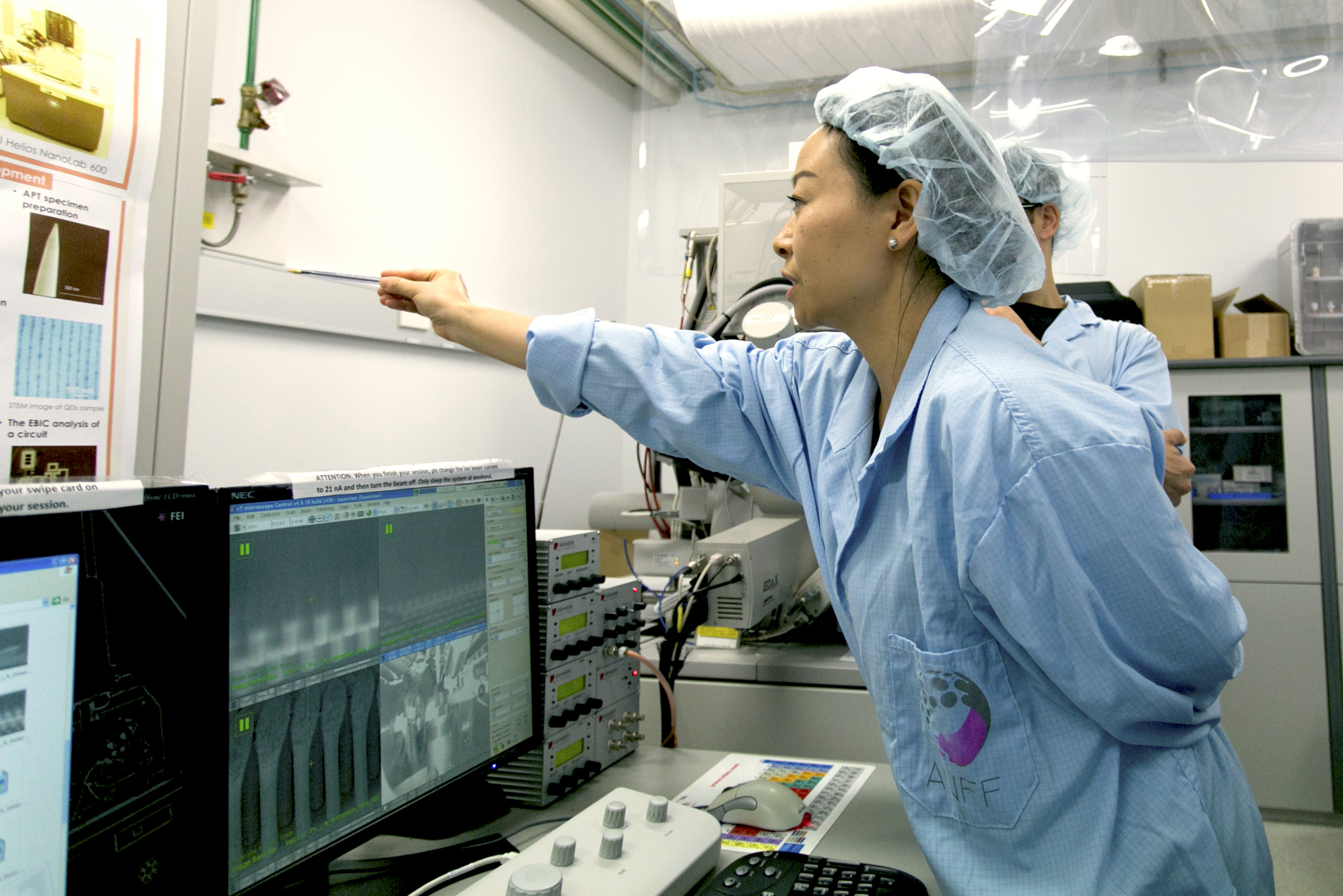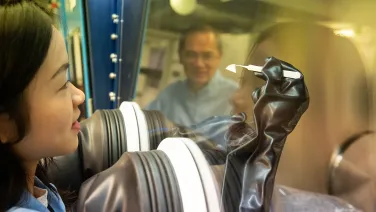Imagine a laser toothbrush: scientists create array of nanowire lasers

Scientists have created lasers from perfect crystals one hundredth of the diameter of a human hair.
Like the fibres of a toothbrush, the team created an array of vertical crystals, termed nanowires, on a platform, and succeeded in making them simultaneously emit laser light for the first time.
Dr Fanlu Zhang, co-first author of the publication in Light: Science & Applications, said the success was a result of exquisitely controlled crystal growth using a vapour deposition technique known as epitaxy.
“Through this new method of epitaxial growth, we can precisely control the diameter and length of nanowire structures with high crystal quality and uniform morphology.
“This makes it possible to design controllable nanowire optical cavities,” said Dr Zhang, who conducted the research during his PhD in the Department of Electronic Materials Engineering (EME) and the ARC Centre of Excellence for Transformative MetaOptical System (TMOS).
The result is the significant step in a decade-long development of arrays of thousands of nano-lasers integrated onto a small chip. Such tiny lasers are an important component for future photonic chips – components that could replace conventional electronics with faster and less noisy light-based signals.
Light-based technologies such as this are crucial for devices that use facial recognition, or lidar navigation.
The EME/TMOS group have previously achieved lasing from single nanowires, by breaking them off the indium phosphide base and laying them horizontally, which allows their smooth exposed ends to act as the mirrors needed to create a laser cavity.
But for many applications vertical light emission is more useful. That requires reflectivity at the base of the nanowire, which does not occur if the nanowires are made of the same material as the base.
So the team attempted to grow the indium phosphide nanowires with a large lateral growth over a silicon dioxide base, so that the refractive index difference at the interface could act as the lower mirror of the laser. However the results were disappointing at first, said Professor Lan Fu, the leader of the group.
“It was hard to grow the smooth crystals we needed. Initially the morphologies were ugly. We had to work out how to engineer the materials precisely.”
Dr Zhang’s careful investigation of the growth dynamics revealed that the type of crystal he grew depended on the temperature, as well as the vapour phase environment during the epitaxy.
The recipe he developed for creating nanowires involved starting with a silicon dioxide template drilled with nanolithography. Nanowires were then built onto this template using epitaxy at a high temperature, in vapour with a low ratio of Group V elements (e.g. phosphorus, arsenic) to Group III elements (e.g. indium, gallium).
The lattice structure of the nanowires created in this process is hexagonal, not the usual cubic structure of indium phosphide, and the crystals grow long.
Once the requisite length was reached, the vapour was changed to a lower temperature with a higher Group V to Group III ratio. In these conditions the growth pattern reverted to a cubic structure, which, rather than growing longer, wrapped around the nanowires as an external layer that made them fatter.
By making the external layer a different material, indium gallium arsenide, Dr Zhang created a quantum well, a quantum structure critical for efficient light emission.
The laser structure was completed by the smooth top surface of the nanowire, and the silicon dioxide interface at its base. These reflective ends confined the light emitted by the quantum well and formed a fabry-perot laser cavity.
The team can control the wavelength of the laser light by changing the ratio of indium and gallium in the quantum well layer. They were able to span the full width of the light wavelengths used for telecommunications, from 1300 nanometres to 1550 nanometres.
The approach has the potential to be used for large scale manufacturing, said co-first author, Associate Professor Xutao Zhang.
“The technology will enable the batch construction of nanoscale laser light sources in the near-infrared telecommunication band. This approach has the potential to overcome the obstacles associated with traditional methods of fabrication and demonstrates a promising path for large-scale photonic integration.”
In this device, the energy to drive the laser is provided by light, however effective operation on a photonic chip would require that energy to be provided electrically.
In previous work, Professor Fu has built nanowires with PN junctions, which will be the way toward for electrical injection.
“It’s tricky doing everything at the nanoscale: for successful lasing you need very low loss, and the extra layers and electrical contacts can introduce imperfections and make hotspots that damage the laser performance,” Professor Fu said.
“But if we can demonstrate electrical pumping it will make it really attractive to industry.”
This article was first published by ANU Research School of Physics.



